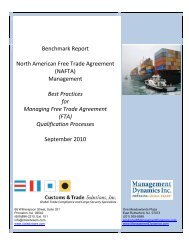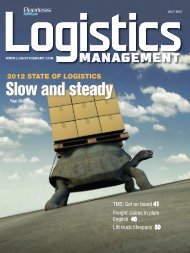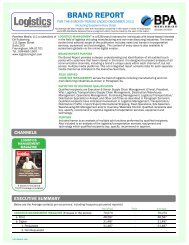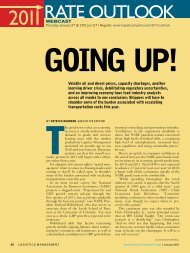Logistics Management - June 2010
Logistics Management - June 2010
Logistics Management - June 2010
You also want an ePaper? Increase the reach of your titles
YUMPU automatically turns print PDFs into web optimized ePapers that Google loves.
Pearson on<br />
What can supply chain executives<br />
learn from the Iceland volcano<br />
On April 14, <strong>2010</strong>, Iceland’s Eyjafjallajokull<br />
volcano erupted, sending a stream of ash into the<br />
sky. Within 24 hours, British airspace was shut<br />
down. Within 48 hours, a major part of European<br />
airspace was closed.<br />
Stories of stranded vacationers grabbed most<br />
of the headlines. However, the magnitude of business<br />
disruption was similarly dramatic. With more<br />
than 60,000 flights grounded in the first week,<br />
companies found themselves unable to ship goods<br />
by air. The impact was (and continues to be) felt<br />
far from Europe—from rose farms in Kenya to<br />
auto assembly plants in the United States.<br />
The worst hit businesses are those with<br />
extended supply chains, short-life-cycle products,<br />
or high-cost, lightweight goods such as electronics<br />
and pharmaceuticals. By volume, only 2 percent of<br />
freight is shipped via air. But that 2 percent of volume<br />
equals 35 percent when measured by value.<br />
In the short term, many companies scrambled<br />
to find ways to move goods as cargo flights were<br />
grounded. Road, rail, and ocean freight carriers<br />
saw a surge in activity.<br />
For some, however, it was too late. Produce<br />
and fresh flowers are already being destroyed by<br />
the ton. Countries are only beginning to gauge the<br />
extent of the economic impact, which will certainly<br />
reach into the billions of dollars for many.<br />
Lessons for the longer term<br />
In the future, scientists may be able to foresee<br />
natural disasters with greater regularity. But<br />
perhaps businesses should consider the volcano<br />
a clarion call for more dynamic supply chains.<br />
Dynamic supply chains are shaped by examining<br />
an organization’s potential exposure to all risks,<br />
identifying vulnerabilities, and then building in<br />
the flexibility to adapt to sudden changes in the<br />
environment without disrupting the enterprise or<br />
impacting market value.<br />
New capabilities in several areas can help to<br />
create a more dynamic supply chain:<br />
Sourcing: Sole-sourcing and using low-cost<br />
Mark Pearson is the managing director of the Accenture’s<br />
Supply Chain <strong>Management</strong> practice. He has worked in supply<br />
chain for more than 20 years and has extensive international<br />
experience, particularly in Europe, Asia and Russia. Based in<br />
Munich, Mark can be reached at mark.h.pearson@accenture.<br />
country suppliers are great strategies for reducing<br />
costs, but better balance is needed to ensure flexibility.<br />
A more-streamlined process for bringing<br />
new suppliers on board could allow companies to<br />
quickly find and use new sources of commodity<br />
goods in an emergency. And for critical materials,<br />
a diversified supplier strategy may offer the flexibility<br />
needed to better mitigate risk.<br />
Manufacturing: Offshore production has<br />
brought tremendous cost reductions for companies,<br />
but it may also subject them to more disruptions.<br />
A flexible manufacturing strategy involves<br />
options for building critical products in multiple<br />
locations, with fast changeover capabilities in<br />
place to allow production to react to sudden shifts<br />
in supply and demand.<br />
Product design: The best strategies for a<br />
more flexible supply chain start at the design<br />
stage. Products designed with manufacturing<br />
flexibility in mind reduce complexity and leverage<br />
common platforms and parts. This can reduce<br />
exposure to supply outages.<br />
<strong>Logistics</strong>: A global transportation network—<br />
one that is optimized for cost and risk—considers<br />
multiple routes to market as well as contingency<br />
shipping plans. A good example is the Dutch<br />
mail and express group TNT. When its national<br />
air space was closed, TNT smoothly switched<br />
intercontinental shipments from its air hub in<br />
Liege, Belgium, to an air gateway in Madrid.<br />
Shipments that would ordinarily be air freighted<br />
across Europe were diverted onto TNT’s existing<br />
European road network. Centralized management<br />
of the network and a common systems platform<br />
enabled TNT to re-route freight relatively easily.<br />
Using a proactive approach, the company kept<br />
customers informed via the media, its website,<br />
and its customer account teams.<br />
When the next traumatic weather event<br />
occurs, the ability to respond with a dynamic,<br />
flexible supply chain could distinguish high-performance<br />
businesses from the rest. Those companies<br />
with resilience built into their supply chains<br />
will likely have the ability to reduce exposure to<br />
transportation cataclysms. They may also be able<br />
to reduce exposure to a wide range of other supply<br />
disruptions that—like bad weather—are more<br />
or less inevitable. M<br />
22 <strong>Logistics</strong> <strong>Management</strong> WWW.LOGISTICSMGMT.COM | <strong>June</strong> <strong>2010</strong>

















